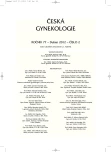Heterotopic pregnancy as an complication during pregnancy and labour – the case report
Authors:
T. Lukášová 1; T. Ventruba 2; P. Ventruba 1; J. Žáková 1; K. Sochorová 1
Authors‘ workplace:
Gynekologicko-porodnická klinika LF MU a FN Brno, přednosta prof. MUDr. P. Ventruba, DrSc., MBA
1; Chirurgická klinika LF MU a FN Brno, přednosta prof. MUDr. Z. Kala, CSc.
2
Published in:
Ceska Gynekol 2012; 77(2): 153-156
Category:
Original Article
Overview
Heterotopic gravidity (HG) is a rare co-existence of intrauterine and ectopic pregnancy with higher incidence in pregnancies after in vitro fertilisation (IVF). Diagnosis of HG is demanding. HG is commonly identificated when rupture or hemoperitoneum occurs.
Case report:
35-year-old woman after 3rd cycle of IVF for absolute tubar factor. Two embryos transfered. Ectopic implatation of second embryo in uterine corner occured. Patient hospitalized with acute deteriorating symptoms of hemoperitoneum in 6th week of gestation. Diagnostic laparoscopy performed with ectopic cornual gravidity detection. Decision made to retain the intrauterine gravidity. Induction of the labour in the 40th week of gestation performed. Placenta retained after the delivery of a normal newborn. Lysis manualis performed, uterine hypothonia followed. On suspicion of placenta percreta laparotomy indicated. Acute supracervical abdominal simplex hysterectomy performed. Histologic examination confirmed the diagnosis of placenta percreta.
Conclusion:
The diagnosis of HG is based on the assesment of clinical symptoms, transvaginal ultrasound and endoscopic diagnostics with eventual intervention. In case of hemoperitoneum urgent surgical intervention indicated. Placenta percreta is a rare complication increased in incidence by the presence of myometrial dammage usually from past uterine surgery. Presence of the scar tissue and abnormal placentation might also be a random coincidence. Placenta percreta is a life threatening complication with a great risk of hemmorhage and commonly requires acute surgical intervention.
Key words:
heterotopic gravidity, ectopic gravidity, in vitro fertilization, placenta percreta.
Sources
1. Kuřecová, B., Hudeček, R., Ventruba, P., et al. Incidence ektopické gravidity po technikách in vitro fertilizace ve dvacetiletém klinickém materiálu Centra asistované reprodukce CAR 01 LF MU FN Brno. Čes Gynek, 2007, 72, s. 389–392.
2. Vavrušová, R., Hudeček, R., Kuřecová, B., Ventruba, P. Diagnosticko-terapeutický algoritmus heterotopické gravidity. Prakt Gyn, 2007, 2, s. 66–69.
3. Blickstein, I., Keith, LG. Multiple pregnancy: epidemiology, gestation & perinatal outcome. Abingdon: Taylor and Francis, 2005, p. 151–155.
4. Tenore, JL. Ectopic pregnancy. Am Fam Physician, 2000, 61, p. 1080–1088.
5. Stafford, I. Placenta accreta, increta a percreta. Část první: Týmová péče začíná již prevencí. Gynek po Prom, 2008, 3, s. 13–19.
6. Resnik, R. Managing placenta acreta. Contemporary Ob/Gyn, 2001, 11, p. 122–129.
7. Koliba, P., Geržová, H., Lattová, V. Ektopická gravidita v souvislosti s IVF a ET. Prakt Gyn, 2004, 5, s. 14–15.
8. Talbot, K., Simpson, R., Price, N., Jackson, SR. Heterotopic pregnancy. J Obstet Gynaecol, 2011, 31(1), p. 7–12.
9. Allahdin, S., Voigt, S., Hrwe, TT. Management of placenta praevia and accreta. J Obstet Gynaecol, 2011, 31(1), p. 1–6.
Labels
Paediatric gynaecology Gynaecology and obstetrics Reproduction medicineArticle was published in
Czech Gynaecology

2012 Issue 2
Most read in this issue
- Triple negative breast cancer – prognostically highly unfavourable group cancer of breast
- Possibilities of IVF in native cycle
- Urinary tract infections in pregnancy: when to treat, how to treat, and what to treat with
- Vaginal birth after previous caesarian section – outcomes analysis 2007–2010
